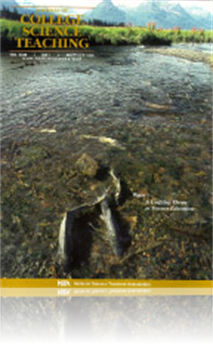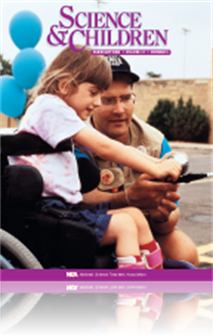All Resources
Journal Article
After the Bell: Family viewing
If no specific homework needs to be completed, family viewing of science-related programs is enjoyable and rewarding and a no-pressure learning experience....
Journal Article
This article describes a course in experimental science for preservice elementary education students. Through “directed discovery,” students collaborate in developing and executing a plan to investigate water as a common thread in biology, chemis...
Journal Article
In this column the leadership of SCST shares its views with JCST readers. In this month’s issue the focus is on the first SCST goal: Improvement in the teaching of college science courses via interdisciplinary interactions among teachers of college...
Journal Article
The Sky’s the Limit: Parents and first-grade students observe the sky
In this study of the sky and moon, students went outside after school each day to observe the sky and record their observations in their moon journals. The unexpected surprise was the involvement and reactions of students’ parents. This journal act...
Journal Article
In over 18 years of operation, the Michigan State University’s “Spartan Speakers Program” has provided over 346 quality seminars, discussions, and workshops at over 40 four-year and community colleges throughout the state of Michigan. This arti...
Journal Article
Guest Editorial: In Search of Science for All
An opinion piece about the issue of inclusion in the elementary science classroom....
Journal Article
This article describes a new teaching strategy employed in a senior-level microbiology course where up to 25 students are introduced to and conduct semester-long original research projects. The paper presents examples of several student projects. Ove...
Journal Article
Using the inquiry method, nonscience majors in Portland State University’s Natural Science Inquiry classes complete student-directed projects, individually and in groups, that tackle scientific, ethical, political, and social issues. By observing, ...
Journal Article
Fresh water is one of our most important resources, yet 97 percent of Earth’s water is salt water and an additional 2 percent is frozen in glaciers and ice caps. That means that only 1 percent of the world’s water supply is available for drinking...
Journal Article
The phenomenon of complementation is not only one of the most important, but it is also one of the most challenging concepts for undergraduate genetics students to grasp. Complementation occurs when parents with the same mutant trait have offspring t...
Journal Article
Editor's Roundtable: Drawing conclusions
Science Scope’s editor shares thoughts regarding the current issue....
Journal Article
Out of Sight: Investigating Unseen Objects
In this module, students measure and map unseen objects hidden within boxes representing the ocean floor. These instructional activities use the element of mystery to motivate student inquiry in a manner that promotes discovery learning in an interdi...
Journal Article
What Research Says: What Have Researchers Been Saying About Science Fairs?
To help stimulate more interest in science fairs, this article offers a brief history and rationale of the science fair, discusses the research that has been done on science fairs, and describes how science fairs have grown to become an international...
Journal Article
In clinical laboratories, molecular methods of DNA analysis such as the polymerase chain reaction (PCR) are used to identify fungal and bacterial pathogens, parasites, and important viruses. This laboratory will fit into many teaching settings to sho...
Journal Article
May is American Wetlands Month—an opportunity to leave the classroom and excite students with guided hands-on experiences in nature. In this article, the National Audubon Society provides a naturalist's view of wetlands, an activity, and a list of ...







